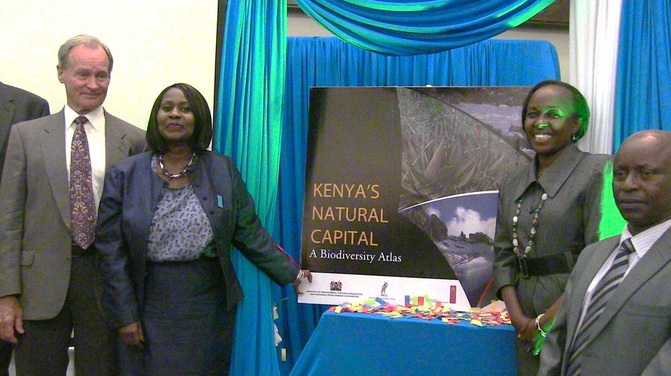 From left, CS Prof. Judi Wakhungu, Dr. David Western and other stakeholders during the launch
From left, CS Prof. Judi Wakhungu, Dr. David Western and other stakeholders during the launch Here are some excerpts from the opening chapter of the atlas:
Kenya is known as the safari capital of the world, a place where rhinos, lions and giraffe stroll by tourist vehicles within sight of bustling downtown Nairobi.Less publicized is Kenya's majestic scenery. The nation’s rich collage of landscapes range from the Chalbi Desert in the north to the snow clad peaks of Mt. Kenya, from the white beaches of the Indian Ocean to the shores of Lake Victoria, and from the rolling plains of Maasai Mara to the floor of the Great Rift Valley. Kenya is also the foundry of varied cultures and lifestyles rooted in the productivity and diversity of its landscapes. Over forty ethnic groups spanning hunter-gatherers, herders, farmers, fishermen artisans and traders depended for eons on the providence of the land, soils, waters, plants and animals.
The interactions between topography, soils, hydrology, plants, animals and peoples within each eco-climatic zone create locally distinctive ecosystems, including forests, woodlands, shrub-lands, grasslands, deserts, wetlands, lakes and rivers, montane, afro-alpine and marine ecosystems. Kenya, ranks among the world’s richest biodiversity nations and hosts over 35 000 species, including more than 7000 plant species and many endemic, rare, endangered and threatened species.
Kenya’s Natural Capital: A Biodiversity Atlas is a national endeavor commissioned by the Ministry of Environment, Water and Natural Resources to document the natural wealth of Kenya. The atlas gives provisional maps of Kenya's biodiversity. It explains what accounts for the richness of its ecosystems and the survival of its unique mega fauna in the 21st century. The atlas also looks at the status and threats of Kenya's biodiversity; the values it affords society; the steps taken to protect it and the challenges ahead. It further points to the need for Kenya to fully value its natural capital and provides a framework and case studies for how to do so.
Finally, the atlas points to a new vision and strategy for how Kenya can incorporate natural capital as one of the pillars of its national development alongside the economic and political pillars on which Vision 2030 is founded. It is intended above all to give Kenyans in all walks of life an atlas that recognizes and values the rich biodiversity of our country and lays the foundation for a sustainable future rooted in conservation and efficient use of natural capital.
At the launch, the African Conservation Centre, in collaboration with the African Centre for Technological Studies, released policy briefs on the use and applications of the atlas for national policy makers, country decision-makers, the business community and learning institutions.
The atlas will be freely available online and continually updated in digital form.
 RSS Feed
RSS Feed
